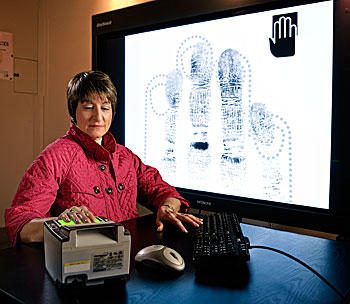FY13: Measurement Science and Standards in Support of Forensic Science
(+$5 million)
Challenge

Forensic science must also deal with an incredibly wide range of interdisciplinary fields from DNA sequencing to electron microscopy to the visual matching of patterns like footprints or tool marks. Often evidence samples are degraded, incomplete, or available only in very small amounts. This too presents challenges for developing the full range of measurement tools required for ensuring confidence in results.
In 2009 a committee of the National Research Council (NRC) made a number of important recommendations for strengthening the public's trust in forensic science findings. Included was strong support for improved measurement and validation methodologies, development of additional forensic standards, and dissemination of best practices to strengthen the precision and reliability of forensic science analyses.
NIST has a long history in advancing forensic science and was specifically cited by the NRC as one of several federal agencies that should collaborate on developing new forensic measurements and standards. Working with the National Institute of Justice and other agencies, NIST has measurement science research under way in chemical, biological, radiological, and nuclear detection and analysis; fire and explosives analysis; gunshot residue, latent fingerprints, and many other areas. NIST's work in DNA profiling and testing, for example, helped establish the methods now used by all crime laboratories to match individuals to evidence samples.
Despite its long experience in the field, the bulk of NIST's efforts have been on narrowly targeted projects funded by other agencies. This proposed initiative will enable NIST to create a strategic program to broadly address the most critical issues in forensic science today.
Proposed NIST Program
Examples of priority program areas will include:
- new reference methods and technologies for understanding crime scenes and identifying criminals, including the uncertainty and standards associated with those techniques;
- improved calibration systems, reference materials and databases, and technology testbeds for ensuring reliable and accurate forensic practices; and
- development of rigorous training programs.
Expected Impacts
A major outcome of this initiative will be to strengthen the utility and reliability of forensic evidence in the courtroom.
This work also has the potential for significant cost savings for the U.S. justice system by reducing the number of mistrials or retrials related to questions about forensic analysis. One economic analysis of cost savings from forensic DNA testing alone estimated a cost savings of $35 for every dollar invested; the same analysis predicted that if DNA testing were fully utilized the U.S. could expect a $12.9 billion annual savings in prevented crime.
Additional anticipated results include:
- new innovative forensic science technologies;
- increased use of documentary standards and measurement services by the forensic community; and
- creation of reference materials, reference databases and new calibration services to improve the consistency of the implementation of forensic science across the nation.

